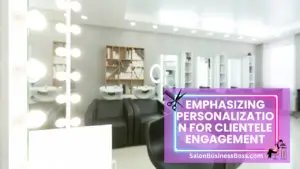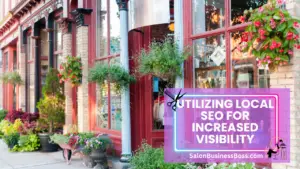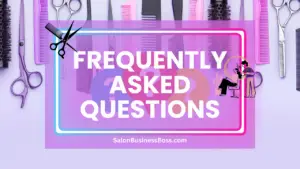The beauty industry is highly competitive, with numerous hair stylists vying for the attention of potential clients. In such a saturated market, effective marketing strategies are essential for hair stylists to stand out and build a loyal customer base.
Hair stylist marketing strategies include personalization for clientele engagement, leveraging social media for brand visibility, creating engaging video content, implementing referral programs, hosting workshops and events, utilizing local SEO, engaging with clients through email marketing, showcasing transformations on the website, forming partnerships with local businesses, and offering loyalty programs to retain clients.
1. Emphasizing Personalization for Clientele Engagement

Emphasizing personalization is a fundamental marketing strategy that sets exceptional hair stylists apart from the competition. Understanding that each client has unique hair needs, preferences, and style aspirations is crucial. By going beyond a one-size-fits-all approach, a hair stylist can build a loyal customer base that keeps coming back for personalized services.
To implement this strategy effectively, it starts with conducting thorough consultations with each client. This is the opportunity to actively listen to their concerns, desires, and expectations. By listening attentively, the stylist gains valuable insights into the client’s lifestyle, personality, and hair goals. Armed with this information, the stylist can then offer tailor-made solutions that perfectly align with the client’s vision.
The benefits of personalization go beyond just providing excellent service. It creates a deeper connection between the stylist and the client, fostering a sense of trust and loyalty. When a client feels understood and valued, they are more likely to return for future appointments and recommend the stylist to friends and family.
Read more about: Unlocking Potential: How to Begin Your Home-Based Hair Business
2. Leveraging Social Media for Brand Visibility
In the era of social media dominance, leveraging these platforms is essential for a successful hair stylist marketing strategy. Popular platforms like Instagram, Facebook, and Pinterest provide a visually engaging way to showcase the stylist’s skills and expertise.
By sharing captivating before-and-after transformations, the stylist can demonstrate their abilities and the transformative power of their services. This visual content resonates with potential clients who are seeking inspiration for their own hair journey.
Consistency is key when using social media. Regularly posting content and engaging with the audience keeps the stylist’s brand at the forefront of followers’ minds. Utilizing relevant hashtags helps reach a wider audience and increases the chances of content discovery.
Engaging with followers through comments and direct messages further strengthens the stylist’s connection with their audience. Responding to inquiries promptly and courteously demonstrates professionalism and excellent customer service.
3. Creating Engaging Video Content
Video content has emerged as a dynamic and captivating tool for hair stylists to showcase their expertise and connect with their audience on a deeper level. By utilizing video platforms such as YouTube, Instagram Reels, or TikTok, hair stylists can demonstrate their skills, creativity, and passion for their craft.
Engaging video tutorials allow stylists to share step-by-step guides on popular hairstyles, haircuts, and color techniques. By breaking down the process and offering valuable tips, stylists empower viewers to experiment with their own hair while positioning themselves as authorities in the industry.
Behind-the-scenes clips provide a glimpse into the stylist’s day-to-day life, giving viewers a sense of authenticity and allowing them to connect with the stylist on a more personal level. This fosters a sense of familiarity and trust, which can be instrumental in attracting new clients.
Client testimonials are powerful social proof that highlights the stylist’s ability to deliver satisfying results. Satisfied clients sharing their positive experiences can influence potential customers and motivate them to book an appointment with the stylist.
By offering valuable hair care tips and advice, stylists demonstrate their commitment to their clients’ well-being beyond the salon visit. This approach not only garners appreciation from viewers but also positions the stylist as a trusted source of knowledge and expertise.
4. Implementing Referral Programs
Referral programs present a win-win marketing strategy for hair stylists. Harnessing the power of word-of-mouth, these programs encourage existing clients to become advocates for the stylist’s services, promoting organic growth for the business.
By offering attractive incentives, such as discounts on future services, complimentary treatments, or loyalty points, hair stylists motivate their current clients to share their positive experiences with friends, family, and colleagues. The referring clients feel rewarded for their advocacy, enhancing their loyalty and likelihood of returning for future appointments.
When new clients are introduced through referrals, they are more likely to trust the stylist’s services from the get-go, as they have received positive endorsements from someone they know and trust. This leads to a stronger initial connection and increases the chances of turning the referred client into a repeat customer.
Referral programs also expand the stylist’s client base, tapping into networks beyond their immediate reach. As the referrals continue to refer others, a snowball effect is created, leading to exponential growth in the client base over time.
Referral programs are cost-effective marketing tools. Compared to traditional advertising, which may require significant financial investment, referral programs rely on the goodwill and satisfaction of existing clients, making them a budget-friendly and sustainable marketing strategy.
5. Host Workshops and Events
Organizing workshops and events is an excellent way for hair stylists to showcase their expertise, build a strong brand presence, and create a sense of community among their clients and potential customers. Workshops can cover a range of topics, from hair care tips and styling techniques to the latest trends and innovations in the beauty industry.
By offering hands-on experiences and interactive sessions, hair stylists can engage attendees on a personal level, allowing them to witness the stylist’s skills up close. This not only boosts the stylist’s credibility but also creates a memorable and enjoyable experience for the participants.
Collaborating with other professionals, such as makeup artists, fashion designers, or skincare specialists, can add value to the events. By providing a holistic approach to beauty and style, the workshops become more appealing to a broader audience, attracting potential clients from different niches.
Events also serve as opportunities for networking and building connections with potential clients and other professionals in the industry. By fostering a welcoming and supportive environment, hair stylists can leave a lasting impression and turn attendees into loyal clients and brand advocates.
6. Utilizing Local SEO for Increased Visibility

For hair stylists targeting a specific local area, local SEO is a fundamental marketing strategy to enhance visibility and attract nearby clients. Local SEO involves optimizing the stylist’s website and online profiles with location-specific information, keywords, and contact details.
To begin with, ensuring that the website includes the stylist’s location, such as city or neighborhood, in key areas like the title tags, meta descriptions, and content, helps search engines understand the business’s geographical relevance.
Creating and claiming the stylist’s Google My Business listing is essential. This listing appears in local search results and provides crucial information like the stylist’s address, phone number, operating hours, and customer reviews.
Consistency in the stylist’s name, address, and phone number (NAP) across all online platforms, including directories and social media profiles, is crucial for local SEO. This consistency helps search engines verify the legitimacy and relevance of the business.
Encouraging positive customer reviews and responding to them promptly enhances the stylist’s local reputation and credibility. Positive reviews not only influence potential clients but also contribute to better rankings in local search results.
Participating in local events, engaging with the community, and creating location-specific content on the website can further strengthen the stylist’s local presence and improve their visibility among potential clients in the area.
Read more about: Beauty Salon Floor Plan: The Art of Spatial Harmony
7. Engaging with Clients through Email Marketing
Email marketing remains a powerful and direct way for hair stylists to engage with their clients, nurture leads, and build long-lasting relationships. Creating a regular newsletter allows stylists to stay in touch with their client base and provide valuable content that adds value to their lives.
Stylists can use email newsletters to share styling tips, hair care advice, and product recommendations. By positioning themselves as experts in the field, they establish credibility and build trust with their audience. Offering exclusive promotions and discounts to newsletter subscribers can also incentivize clients to continue their patronage.
Personalization is key in email marketing. Sending personalized birthday greetings or appointment reminders demonstrates that the stylist values each client and cares about their individual needs. This personalized touch enhances the overall customer experience and fosters a sense of loyalty.
Email marketing also serves as a channel for soliciting feedback from clients, allowing stylists to gather valuable insights and improve their services based on client preferences and feedback.
By maintaining consistent communication through email marketing, hair stylists can keep their brand top-of-mind with clients, leading to increased client retention and referrals. Overall, email marketing is a versatile tool that helps stylists foster strong relationships with their clients and drive business growth.
8. Showcasing Client Transformations on the Salon Website
A stylist’s website is a powerful platform for showcasing their talent and building credibility. Displaying before-and-after photos of client transformations is a compelling way to demonstrate the stylist’s expertise and the transformative power of their services.
High-quality and visually appealing images capture the attention of potential clients and create a positive first impression. Potential clients can visualize the stylist’s skills and imagine themselves achieving similar results, thereby increasing their interest in booking an appointment.
Client testimonials and reviews provide social proof and add credibility to the stylist’s work. Positive feedback from satisfied clients reassures potential clients that they are in capable hands, instilling confidence in their decision to choose the stylist for their hair needs.
Organizing client transformations by different hair types, styles, or occasions can make it easier for potential clients to find inspiration that aligns with their preferences. This organization showcases the stylist’s versatility and ability to cater to a diverse clientele.
Including calls-to-action (CTAs) strategically throughout the website, such as “Book an Appointment” or “Contact Us,” encourages potential clients to take the next step and reach out to the stylist for a consultation or service.
9. Partnerships with Local Businesses
Forming partnerships with local businesses can be a strategic marketing move for hair stylists seeking to expand their reach and attract new clients. Collaborating with businesses like spas, boutiques, or wedding planners allows for cross-promotion, where each partner promotes the other’s services to their respective customer bases. This cross-promotion can lead to increased visibility and awareness for the hair stylist among a broader audience.
Participating in community events and charitable initiatives also offers opportunities for exposure and engagement. Stylists can participate in local fashion shows, wellness expos, or charity fundraisers, showcasing their skills and building relationships with potential clients and community members. Supporting charitable causes not only demonstrates the stylist’s commitment to giving back but also fosters a positive brand reputation in the community.
Building partnerships with local influencers, bloggers, or social media personalities can also extend the stylist’s online reach. Collaborating with these individuals can result in social media mentions, sponsored content, or reviews that can introduce the stylist’s services to a wider audience.
10. Offering Loyalty Programs and Incentives
Loyalty programs and incentives are effective marketing strategies for nurturing client loyalty and encouraging repeat business. By rewarding clients for their continued patronage, hair stylists can strengthen their relationships with existing clients and foster long-term loyalty.
Implementing a loyalty program that offers rewards, such as discounts, free services, or exclusive perks, encourages clients to return for future appointments. The program can be tiered, with increasing benefits as clients accumulate more loyalty points or visits. These rewards create a sense of appreciation and value for the client, enhancing their overall experience.
Offering incentives on special occasions, such as birthdays or anniversaries, further deepens the connection between the stylist and the client. Sending personalized birthday offers or anniversary discounts shows that the stylist recognizes and celebrates these important milestones with their clients.
Complimentary treatments or services after a certain number of visits not only surprise and delight clients but also motivate them to maintain their loyalty and reach the milestone for the reward. This approach serves as an excellent retention strategy, reducing the likelihood of clients seeking services elsewhere.
Conclusion
In the fast-paced and competitive beauty industry, hair stylists must implement effective marketing strategies to engage their audience, increase visibility, and foster client loyalty. Emphasizing personalization, leveraging social media, creating engaging video content, and implementing referral programs are just a few of the tactics that can lead to success. By combining these strategies with excellent customer service and consistent branding, hair stylists can build a thriving business and establish themselves as sought-after professionals in their community.
Frequently Asked Questions

1. How can I handle negative feedback or reviews in my marketing efforts?
Address negative feedback with professionalism and empathy, offering solutions to resolve any issues, and demonstrate your commitment to client satisfaction.
2. Should I use paid advertising for my hair stylist business?
Paid advertising, when targeted correctly, can increase visibility and attract potential clients. However, consider starting with organic efforts before investing heavily in paid ads.
3. Can I measure the success of my marketing strategies?
Yes, tracking key performance indicators (KPIs) such as website traffic, conversion rates, and client feedback can help you assess the effectiveness of your marketing efforts.
To learn more on how to start you own salon checkout my startup documents here.
Please note that the contents of this blog are for informational and entertainment purposes only and should not be construed as legal advice. Any action taken based on the information provided in this blog is solely at your own risk. Additionally, all images used in this blog are generated under the CC0 license of Creative Commons, which means they are free to use for any purpose without attribution.

About the author. Entrepreneur and Salon Business Fan.
Hi! I am Shawn and I am a happy individual who happens to be an entrepreneur. I have owned several types of businesses in my life from a coffee shop to an import and export business to an online review business plus a few more and now I create online salon business resources for those interested in starting new ventures. It’s demanding work but I love it. I do it for those passionate about their business and their goals. That’s why when I meet a salon business owner, I see myself. I know how hard the struggle is to retain clients, find good employees and keep the business growing all while trying to stay competitive.
That’s why I created Salon Business Boss: I want to help salon business owners like you build a thriving business that brings you endless joy and supports your ideal lifestyle.


